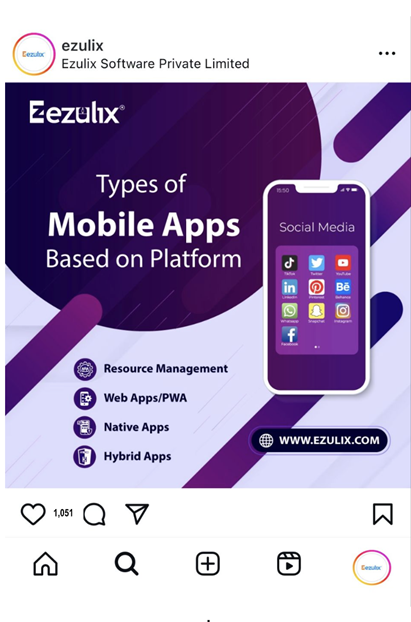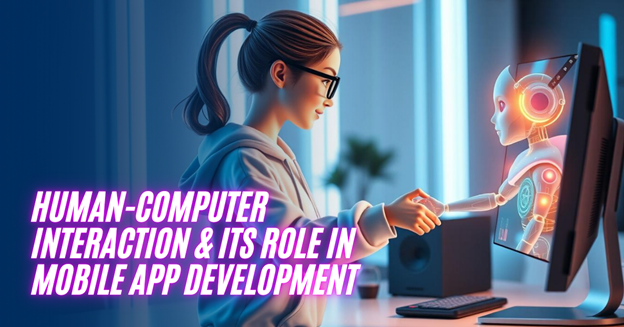Mobile app development is the most glorious phase in the lifespan of any business. It signifies growth and expansion for a business on one hand. On the other hand, it takes user experience to the next level by reducing the physical and mental toil of the users.
Since the early 1980s, researchers have endeavoured to understand how humans like to interact with computers. The aim of all such studies was to find out how to enhance user experience. Simply put, a better user experience results in enhanced user engagement that leads to increased sales, revenues, and customer loyalty.
So, in this blog, we are sharing the key findings of Human-Computer Interaction studies helpful in planning mobile app ideas for a business. If you are planning to launch a mobile app soon. Then remember these key HCI factors to provide the best user experience.
Table of Contents
Understanding Human-Computer Interaction (HCI)
Human-Computer Interaction (HCI) is the branch of study that reveals patterns of human behaviour while interacting with computers (including hardware and software). HCI combines the fundamentals of Human Psychology, Computer Science, Behavioural Science, and Fine Arts.
Ever since the invention of smart devices like computers and smartphones, humans have been growing fonder and fonder. However, what makes humans so fond of smart devices is a key finding for many businesses planning to transform digitally.
Certainly, it is the reduction in workload and stress that makes humans hooked to computers. Mobile applications, especially, play an important role in ‘helping’ humans. Say, for example, E-Commerce apps reduce the physical toil of roaming all day long in crowded markets. Likewise, if you too are launching an app in the market, then note these key findings before you go.
Impact of HCI on Mobile App Development: 6 Things to Learn!
HCI has a major impact on mobile app development. What if you pompously launch a product in the app market, but it fails user satisfaction? Suppose having a food delivery app that makes the user ‘visit’ a far-away restaurant and still wait to quench his hunger.
Similarly, if your mobile app is not user-friendly enough, it loses its charm then and there. Before planning an app idea, keep these 6 HCI factors in mind necessarily:
1. User Experience is the King
User Experience is the heartbeat of any computer program. A mobile app is just like your digital store. A well-entertained customer at your brick-and-mortar store, shop, or office is a thousand times more likely to return to your services
Similarly, a customer who gets a hassle-free, quick, and secure app experience is a thousand times likely to stay engaged with your mobile app. Therefore, offering a speedy and well-organized mobile app to your target audience must be your top priority. Approach only an expert mobile app development company that knows the art and science of crafting user-friendly apps.
2. Mobile Apps For Reducing Cognitive Load
Mobile applications provide services in just a few clicks within a couple of seconds. A customer is least required to put a lot of load on cognition (functioning of the brain). If the user has to read, understand, think, and calculate a lot even with a mobile app. Mark our words, he would never use the mobile app. Rather, as per key HCI findings, he would still demand a human assistant.
As a result, the user interface of a mobile app or any other computer program needs to be simple. Fewer words, more icons, and just 3-4 clicks! This should be the core structure of your mobile app. The customer must get what he/she is looking for within 10-30 seconds of coming to your app. That too without having to perform complex cognitive tasks as mentioned above.

Say, for example, consider the UI of Instagram, the most popular social media app in the present day. As users prefer to either watch posts and reels or search for an account or add/post content on their profile, Instagram has pinned these top 5 features to its home screen.
Additionally, these icons stay pinned no matter whichever page the user switches to. Furthermore, being icon-based, it is easier to identify which button is for what purpose! This elevates user experience by reducing the mental or cognitive load of the users.
3. Your App Must Make Life Easy, Not Difficult
Launching a mobile app must make the lives of your customers easy. Technology is to ‘assist’ and not to ‘challenge’ its users. If your mobile app is too complex to handle or increases the ‘problem’, it is worthless. Say, for example, the purpose of an E-Commerce App must be to:
- Provide shopping experience 24*7
- Digitalising payments
- Saving the customers from standing in long queues
- Waiting to try an outfit outside the trial room for hours
- Saving female customers from buying the wrong shade of makeup
- Collect user behaviour data and make marketing strategies accordingly
However, on the contrary, if your E-Commerce app:
- Is too complex to learn
- Takes too many clicks to find a product
- Takes too much loading time
- Does not load product images and descriptions within a few seconds
- Can’t provide secure digital payments
- Need the customer to fill in lengthy bank details for payment
- Projects wrong makeup shades (in virtual try-on features)
- Does not provide a Size Guide for purchasing outfits
- Charges unfairly extra delivery fees
Then, clearly, it is making the lives of your customers more problematic! Therefore, you must ensure that your mobile app provides fast and anytime anywhere service to your customer. Additionally, it must be easy to use. If it takes a lot of ‘learning’, then certainly it is going in vain.
4. Reduce Costs, Win the Battle
Furthermore, Human-Computer Interaction also grew popular due to indirect factors like reduced cost of acquiring a service. Consider the following instances:
- Paying £2 to £5 for home delivery of an outfit, than bearing the cost of driving to the shop.
- Doing internet recharge online with bare minimum taxes, than driving to and from a physical recharge store.
- Ordering bulk grocery with one-time delivery fee, than visiting departmental store again and again.
Doorstep services through a mobile app reduce the cost of acquiring a service for the customer. Not only the financial cost is reduced, rather the user also gets free of the mental and physical toil.
Therefore, users have grown this fond of mobile applications. So, while planning for mobile app development, remember that you launch an app that reduces the cost for your customers somehow.
Humans interact with Computers to make their lives comfortable. If your app does not offer comfort, then it is not solving the purpose.
Similarly, while taking B2B App development services, you too need to save costs! Therefore, in place of native app development, embrace Hybrid App Development Services. Get a single codebase compatible with Android, iOS, Windows, and MacOS at the cost, time, and effort of one application.
5. Can’t Ignore Emotional Intelligence
‘Personalisation’ and ‘familiarity’ are core to the sales department of every business. Establishing a rapport with the customers build trust and faith in the customers for a business. At present, the biggest debate in the world of Information and Technology (IT) sector is the failure of technology to establish a rapport and emotional connection with the users.
However, recent studies have found that humans like to interact with a computer device exactly the same way they would interact with a family member, relative or a friend. As a result, it is important to ‘humanise’ the output of a computer program.
As of now, developers are yet to discover such algorithms that can make software and applications emotiionally intelligent. However, smart software developers are still capable of software ‘personalisation.’ Methods like-
- Using polite and friendly language with the user
- Sending personlised push notifications
- Calling the user with nick names
- Saving and remembering user data like name, preferences, wishlist etc.
- Proving personlised product/content/service suggestions and more
Can make a mobile application more ‘human-friendl.’ While planning content of the mobile app, the business owner must ensure that the development team uses the kind of language that well-represent decency, client-centricism, and ‘sense of service.’ This makes a user emotionally attached to a mobile app.
6. Make Room for Emerging Trends
Technology is a continuously evolving, changing, growing, and developing discipline. As a result, new innovations keep on coming into being. At present, software engineers are trying hard to make computer programs more ‘human-friendly’, assistive, and ‘advanced’ at the same time. The pipelined innovations, research, and studies center around the following:
Image, Video, Voice, and Biometric Recognition
Recently, Google launched a video recognition feature worldwide. Googlers can now record a video with Google Lens and ask questions about what they see. The app will provide information on customer queries relating it to the objects in the videos. Google will utilise ‘image recognition’ (by processing a video as series of images) and ‘voice recognition’ for the same.
Aspiring mobile app owners must also focus on embedding these advanced features to their apps. These features can enhance accessibility and improve user experience to a great extent. Biometric authentication and searching for a product/service will become much easier with video, image, voice, and biometric recognition. Especially, voice recognition will help those who can’t type and can’t read and write.
Gesture Recognition
For enhancing the user accessibility and providing and immersive user experience, gesture recognition is also a pipelined project. Already, gaming industry is utilising the same in Augmented Reality-driven games. However, suppose using a website without having to touch your device screen? Sounds great? Plan to implement the same on your mobile app!
Brain-Computer Interfaces
One of the most gossiped concept in the IT industry is the Elon Musk’s obsession with ‘mind-reading.’ His endeavors to win over Brain Computer Interface (BCI), a highly aspirational method of Human Computer Interaction are in the limelight. As a result, many competitors will try to conquer BCI technology at the earliest. Eventually, you mobile app structure must be flexible enough to incorporate such high-end technologies whenever needed.
To Hire Mobile App Developers with technologies like Node.JS, Asp.Net, React Native etc can help you get a flexible app structure. The core technology used in Artificial Intelligence (AI) and Machine Learning models revolves around the aforementioned development tech stack. AI and ML are the main tech behind BCI, NLP, Biometric recognition, and image, video, and voice recognition. So, choose a tech stack that makes you futuristic.
Natural Language Processing (NLP)
One of the most crucial Human-Computer Interaction method these days is Natural Language Processing (NLP). As humans now love to ‘talk’ to their smart device for a more ‘personlised’ experience, NLP integration becomes vital to mobile app development. So, make sure that your app responds to voice commands, understand written prompts, and actually ‘speaks’ the output in a user-friendly manner.
Concluding Remarks
The bottom line is Human-Computer Interaction is an indispensable part of the society for ages. However, engineers are striving their best to make this interaction more user-friendly, personalised, and humanised. A human-friendly technology can change the world operates. It can enhance the user accessibility, save a lot of time, money, and efforts, and help a business to operate 24*7 hours throughout the year simultaneously. Therefore, an aspiring mobile app owner needs to keep in mind all these trends while planning to launch a mobile app. The higher the app is ‘humanised’, the better gets the engagement.

